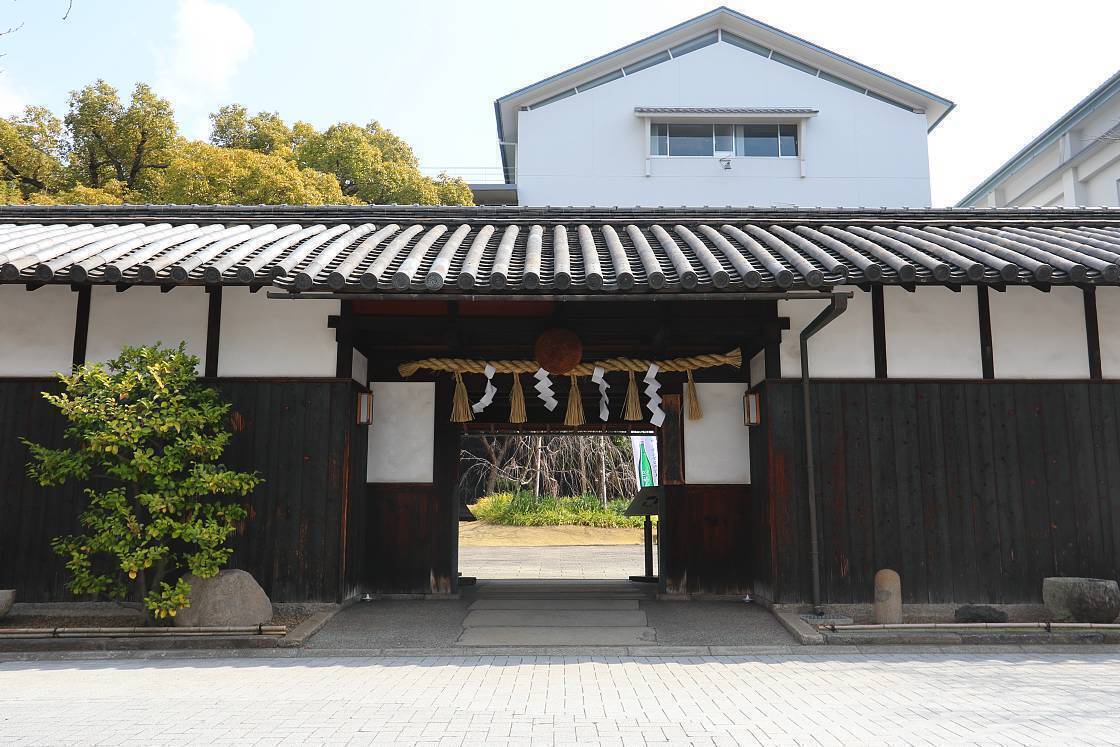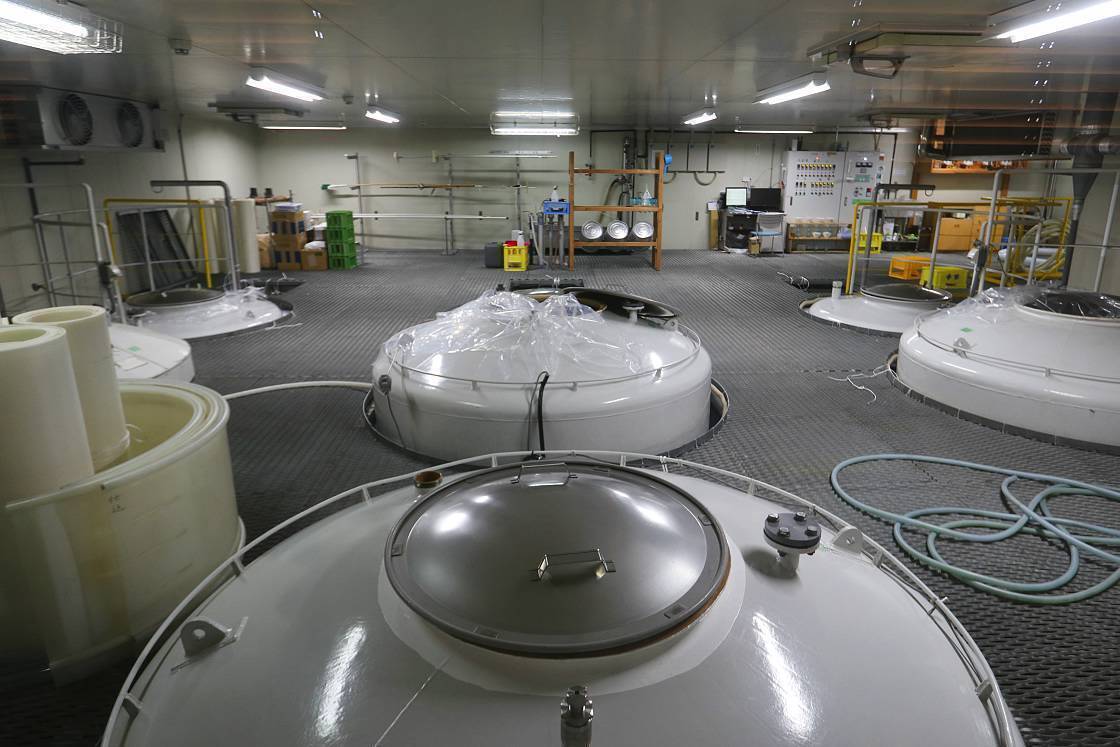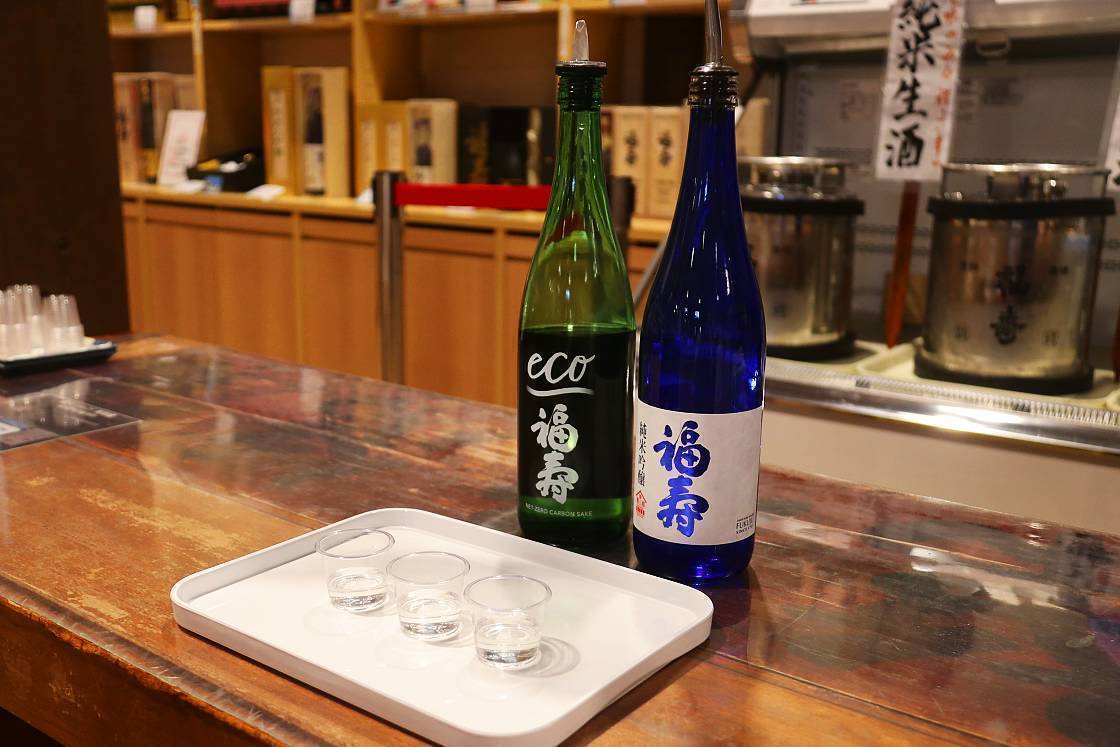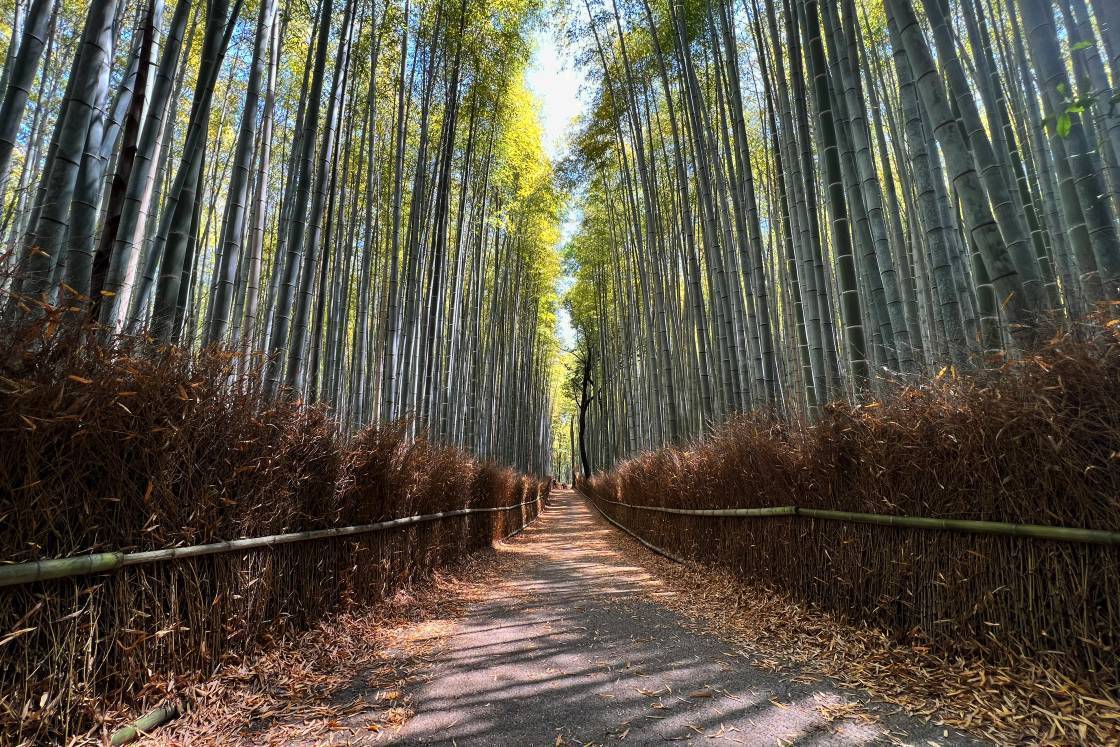Using Hankyu Railway to visit Kyoto and Kobe from Osaka
Instantly recognisable by the maroon color and classic style of its trains, Hankyu Electric Railway connects the cities of Osaka, Kyoto and Kobe in Japan's Kansai Region, making it an invaluable resource to sightseers and commuters alike.
Known for their cozy, wood-paneled interiors and nostalgic feel, Hankyu trains inspire a kind of warmth and fondness in their regular passengers seldom seen in today's world, even serving as the setting of the popular 2011 movie "Hankyu Railway - a 15 minute miracle".
Hankyu's extensive railway network is centered in Osaka's northern downtown district of Umeda and allows tourists to explore Kyoto, Takarazuka and Kobe with a convenient base in Osaka and no need to change hotels. And this is exactly what I did on a recent trip to the Kansai Region, enjoying that unique Hankyu atmosphere, including a ride on the one-of-a-kind Kyo-train GARAKU, or "paradise" train.
Day trip to Kyoto
My day began in Umeda - Osaka's main business district and transport hub - an area dotted with shops, restaurants and high-rise buildings, thrumming with energy amid the early morning rush.
Right at the center of things is Hankyu's Osaka-Umeda Station - built around a large, open atrium connecting seamlessly into the Hankyu Sanbangai Shopping Center and the Hankyu Umeda Department Store, not to mention three of the city's other rail systems including the subway.
Unlike a lot of large stations which can feel somewhat labyrinthine and difficult for first-time users to navigate, Osaka-Umeda Station is the terminus for the three lines it serves, allowing all nine of its platforms to connect into one large, open plan space.
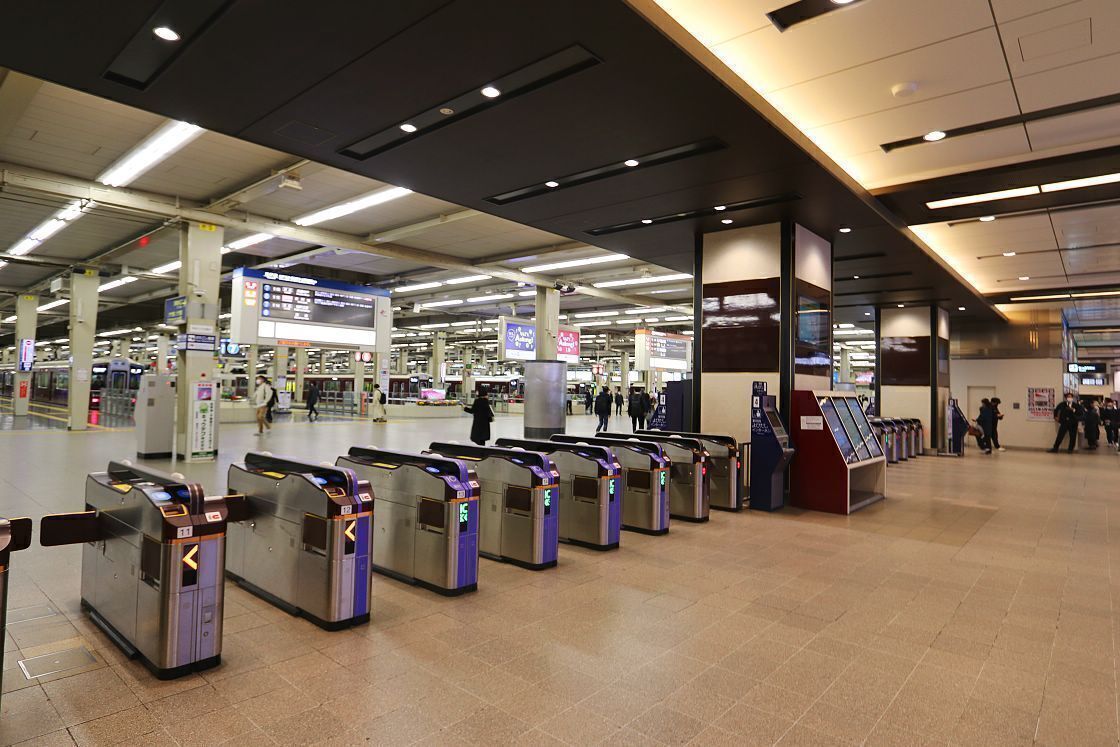
Setting the scene for a day in Kyoto, the city celebrated as the heart of traditional Japan, I would be making the journey on the Kyo-train GARAKU - a special one-of-a-kind train found only on the Hankyu Kyoto Line on weekends and national holidays, when it makes four round trips per day between Osaka-Umeda and Kyoto-Kawaramachi for 410 yen one way (seat reservations not required).
Painted in Hankyu's classic maroon color and with just a handful of unique exterior markings to set it apart, the Kyo-train GARAKU appears at first glance like any other train in the Hankyu fleet. Step inside however, and you'll instantly realize what makes this train so special.
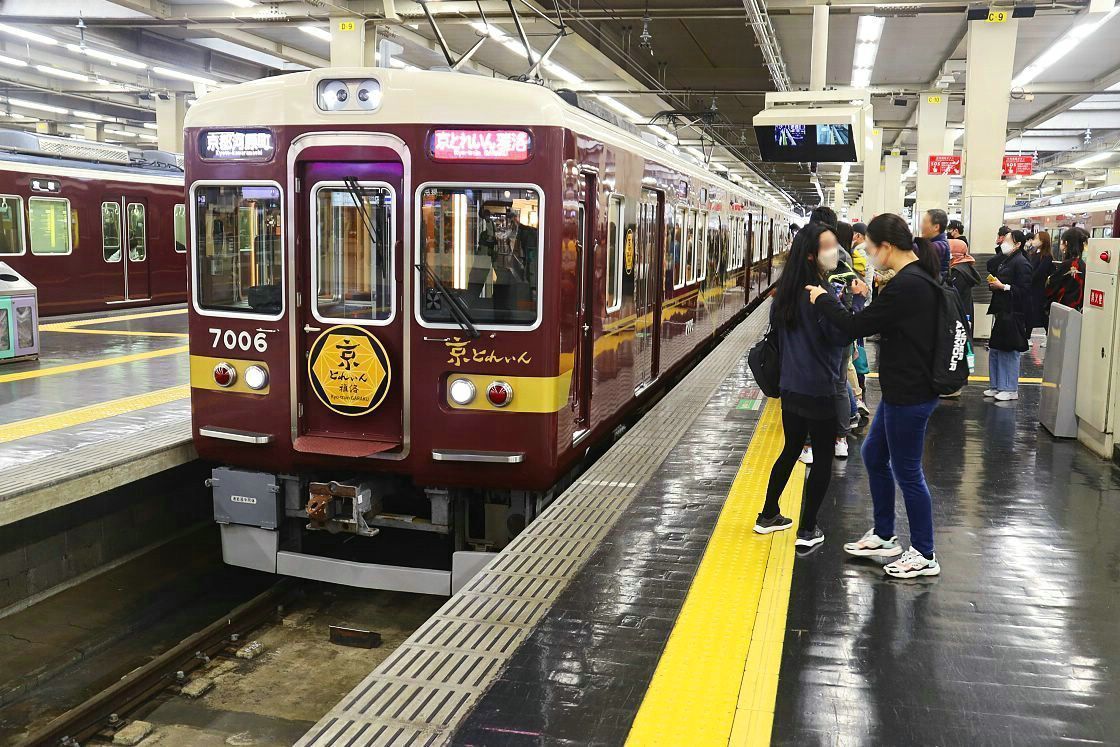

From its wood-paneled walls decorated with framed photographic prints to its finely patterned seat upholstery, every inch of the train's interior is packed with details reminiscent of old Kyoto, giving passengers the feeling of stepping into one of the city's iconic machiya houses.
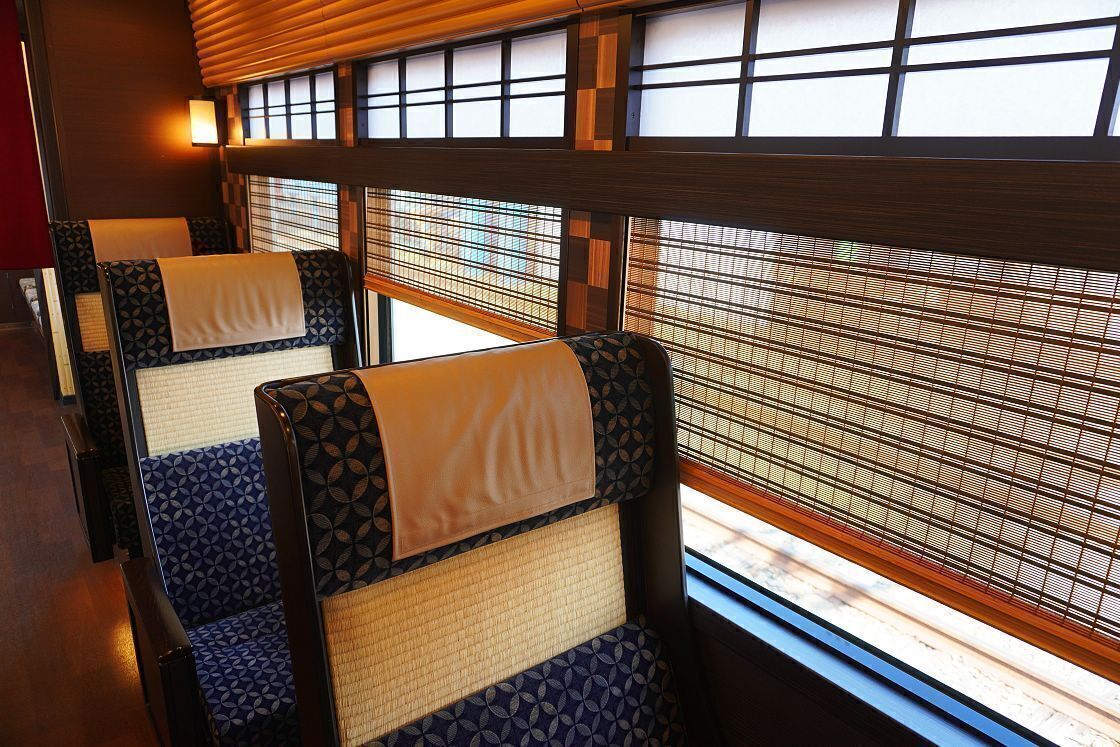
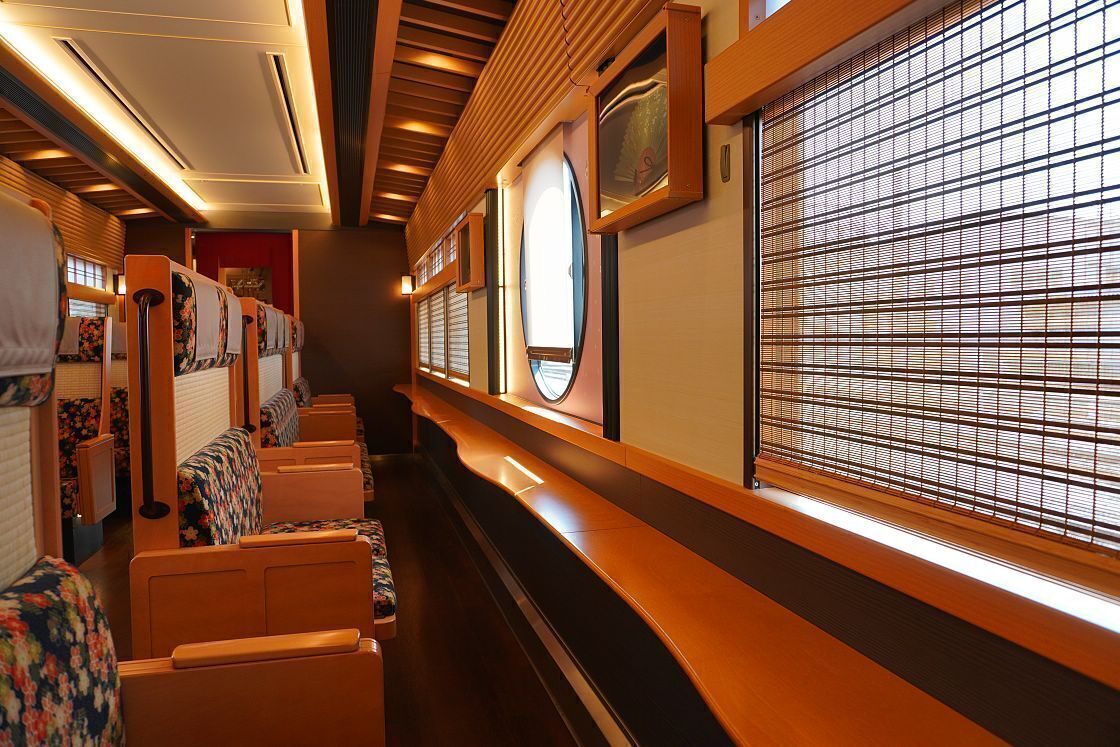
Adding to the sense of discovery, each of the train's six carriages is decorated with its own set of seasonal motifs, from a pattern of scattered maple leaves representing autumn to "snow viewing" windows complete with shoji-style fittings and even a tiny enclosed garden in the winter carriage.
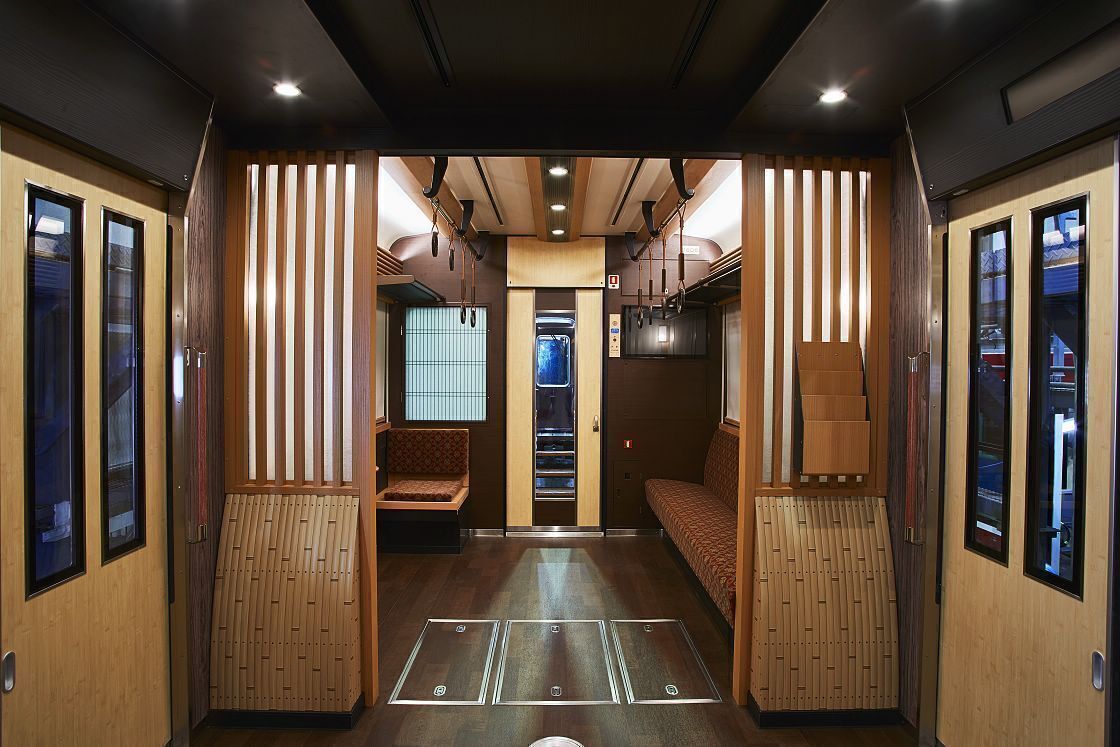

With just a little over half an hour to enjoy the experience, I did my best to slip through the busy carriages this way and that, picking out clever little references to Kyoto art and design. Before long though, the train pulled into Katsura Station and it was time for me to change to the Hankyu Arashiyama Line for my first stop of the day.
Today regarded as a must-see for visitors to Kyoto, Arashiyama has been a sightseeing destination since the Heian Period (794-1185) when members of the Imperial family and other high ranking aristocrats began to develop the area as a scenic retreat, while nearby temples thrived on their patronage.

Arriving into Arashiyama Station, I made my way northwest to the Togetsukyo or "Moon Crossing" Bridge - an impressive 155 meter structure spanning the Katsura River, originally built in 836. While the current bridge is a reconstruction built on concrete piles, it retains a gracefully curving form and is a perfect spot to enjoy the surrounding landscape.
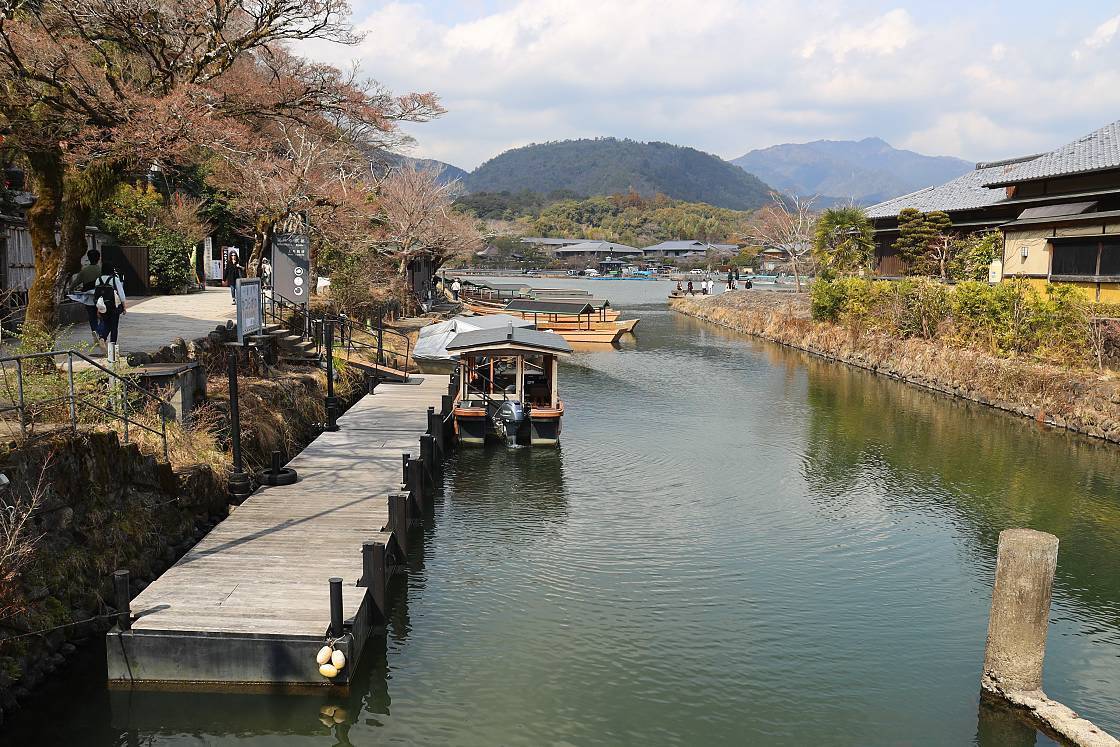
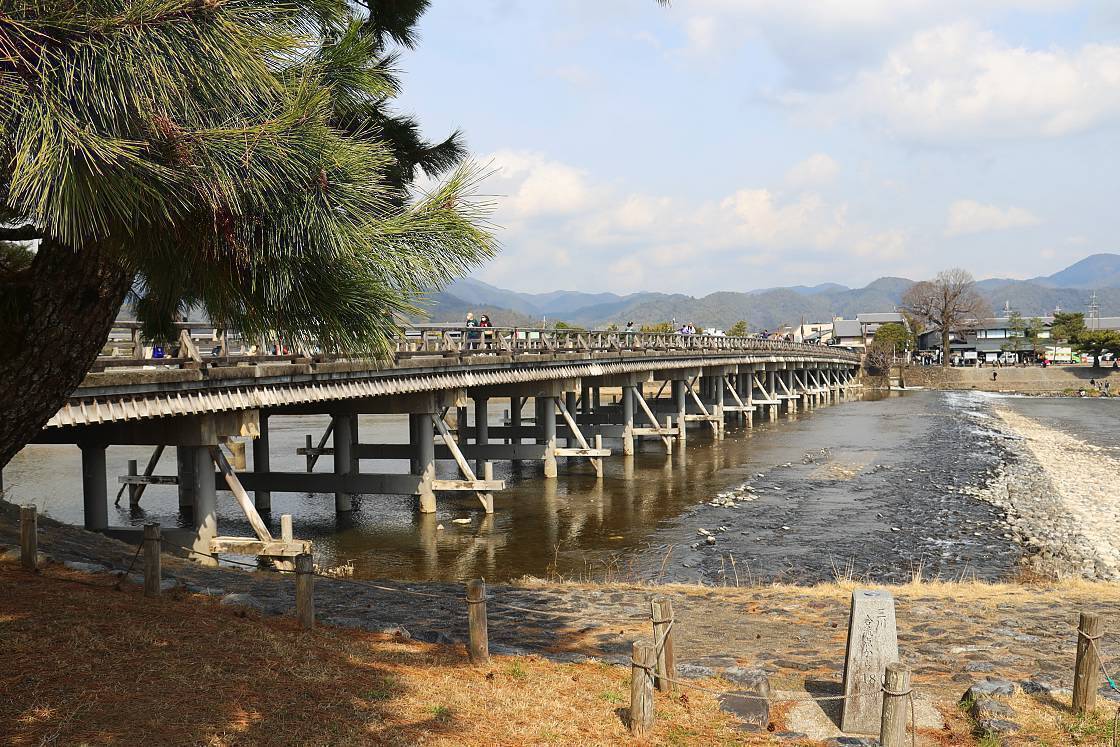
Although I wouldn't be seeing it on this trip, in just a fortnight or so the trees lining the banks of the river would be coming alive with spectacular cherry blossoms. The surrounding hills are also well known for their beautiful autumn colors, while visitors on summer evenings can experience exciting displays of cormorant fishing - another tradition attributed to the Heian elite.
Crossing the bridge, I followed a path along the opposite bank, past an attractive park and into the woods to another of the area's most popular viewing spots - the Sagano Bamboo Grove.
Although just a few hundred meters long, there is something otherworldly and powerfully serene about this beautifully maintained pathway. The bamboo to either side seems to go on forever, towering overhead to create a shifting canopy of leaves.

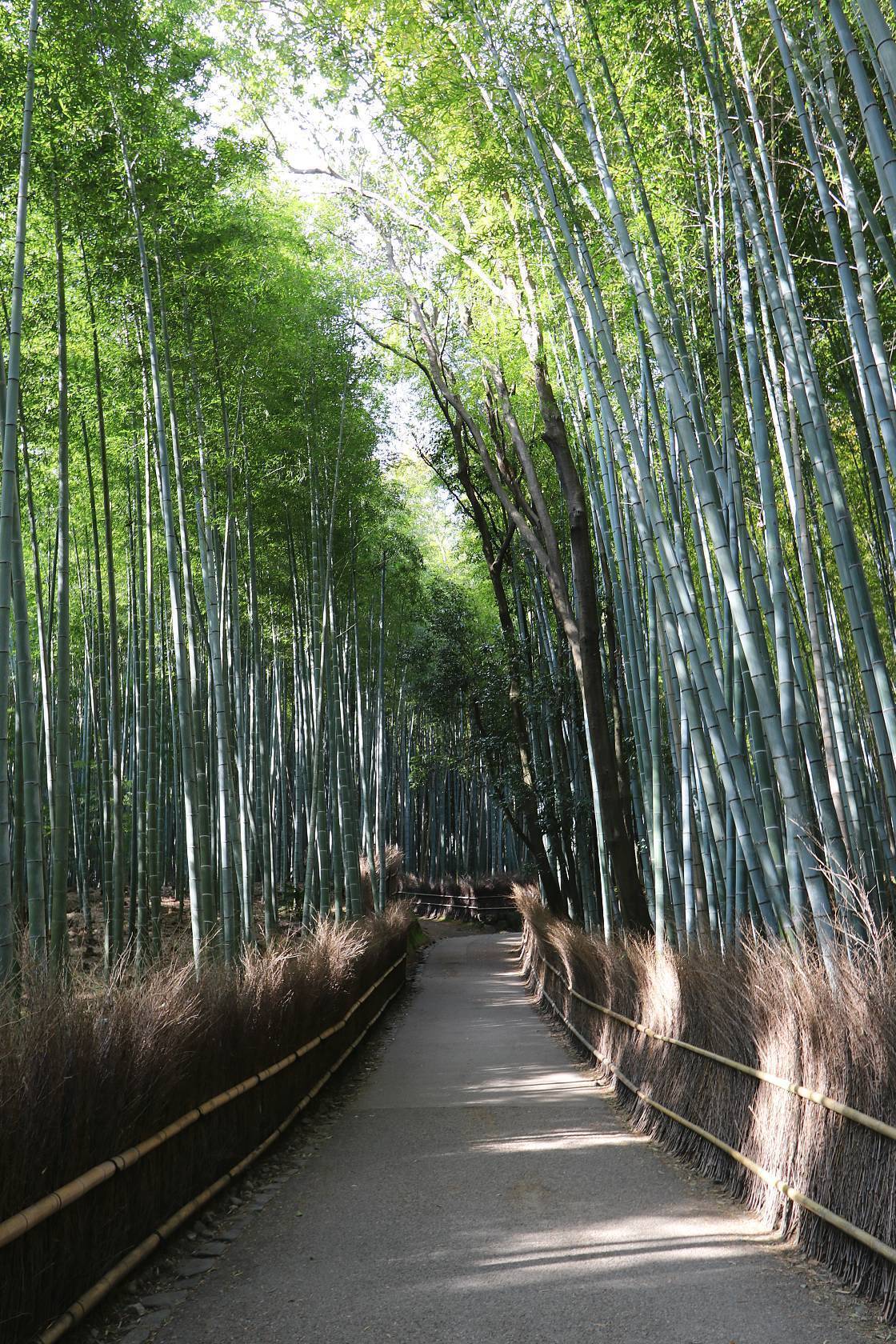
With visitors returning once again in large numbers, a trip to Arashiyama can sometimes seem like a struggle against the crowd - but even in this popular area, there are still some peaceful spots to enjoy a quiet moment. One of my own favorites is Jojakkoji - a temple set in a beautifully manicured hillside garden just a few minutes' walk from the Sagano Bamboo Grove.
Founded in 1596, the temple is today best known for its wonderful Niomon gate, featuring an elegant thatched roof and two imposing guardian statues. From here, visitors make their way up a flight of stone steps to a secluded precinct and the main building - originally located within Momoyama Castle and transported here piece by piece in the early Edo Period.
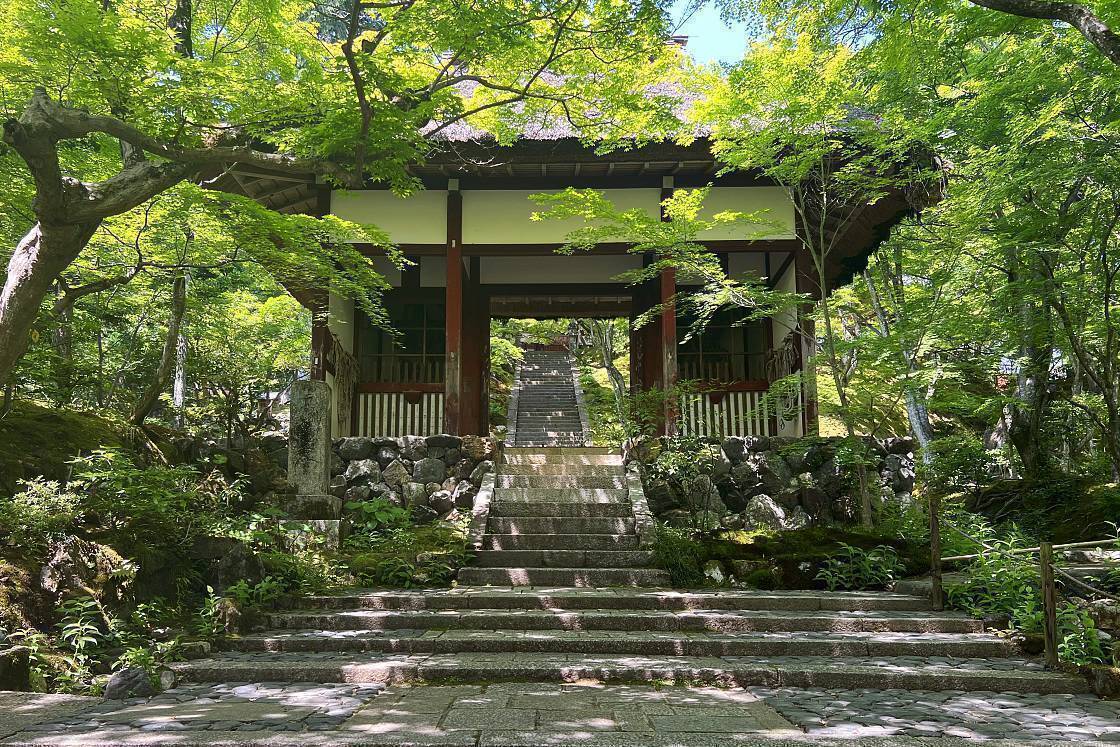

Winding my way uphill beyond the main precinct, I ended my visit with a spectacular view through a gap in the trees towards Kyoto.
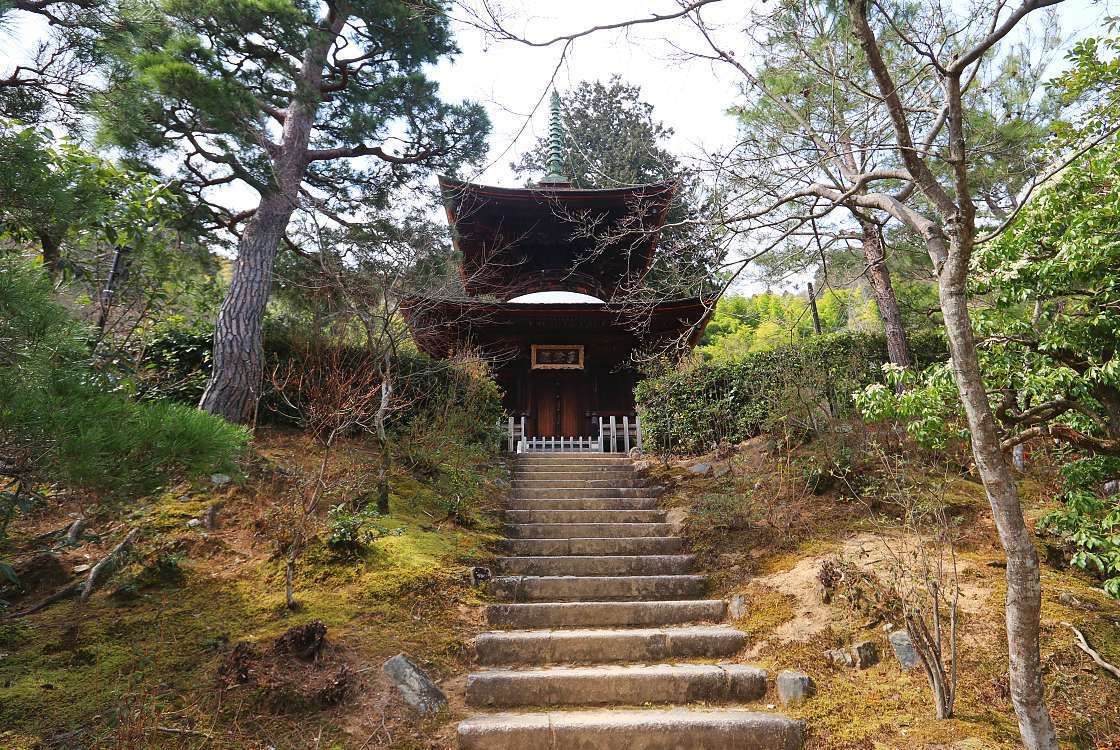
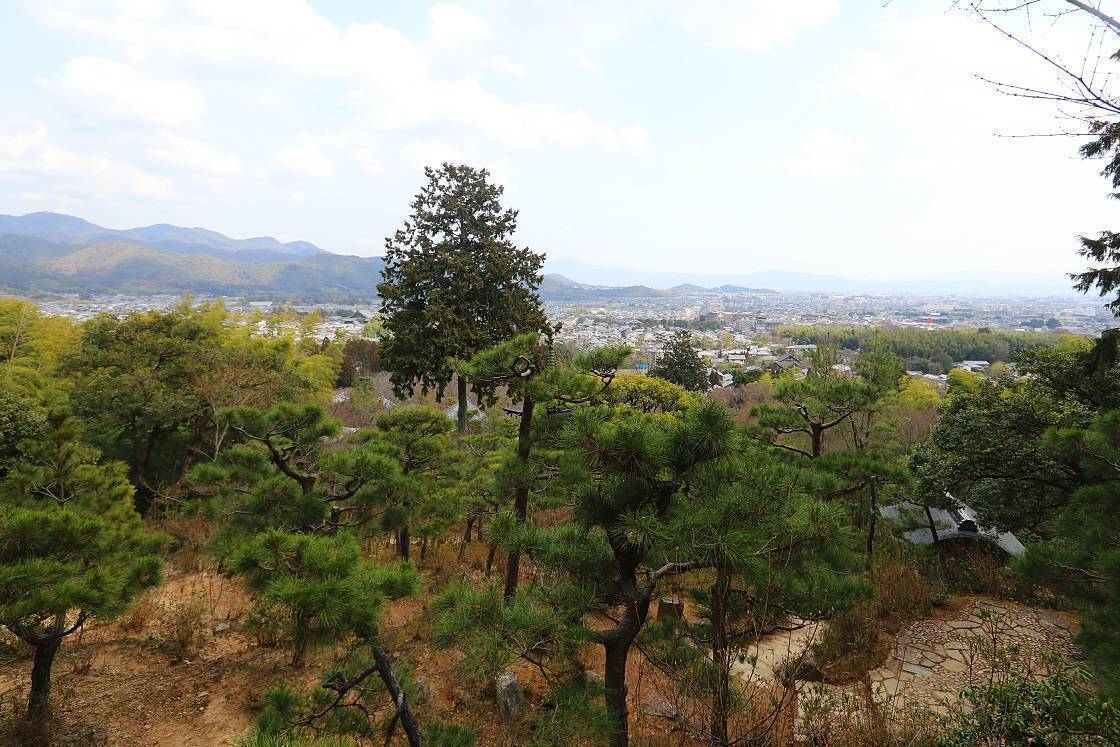
Retracing my steps to Arashiyama Station, I jumped back on the Hankyu Line for a journey into central Kyoto, changing again at Katsura Station to a train bound for Kyoto-Kawaramachi Station. To round off my trip, I would be heading to two classic sightseeing spots in Kyoto's Higashiyama Ward, where I hoped to capture something of the old world ambience the city is best known for.
A pleasant 20-30 minute stroll to the southeast and just a little downhill from the enormously popular Kiyomizudera was my next stop - another beautifully recreated neighborhood in the traditional style called Ninenzaka. A pedestrianized street lined with historic buildings, it's one of the best places to breathe in the atmosphere of old Kyoto - if you don't mind the crowds!
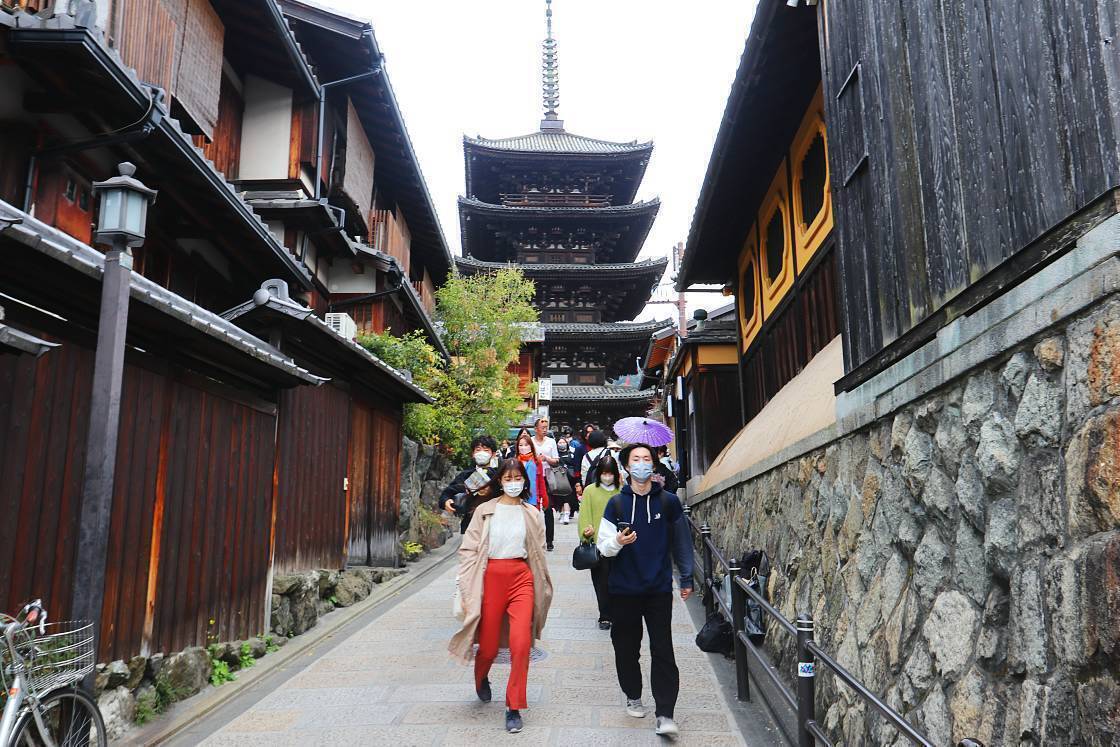
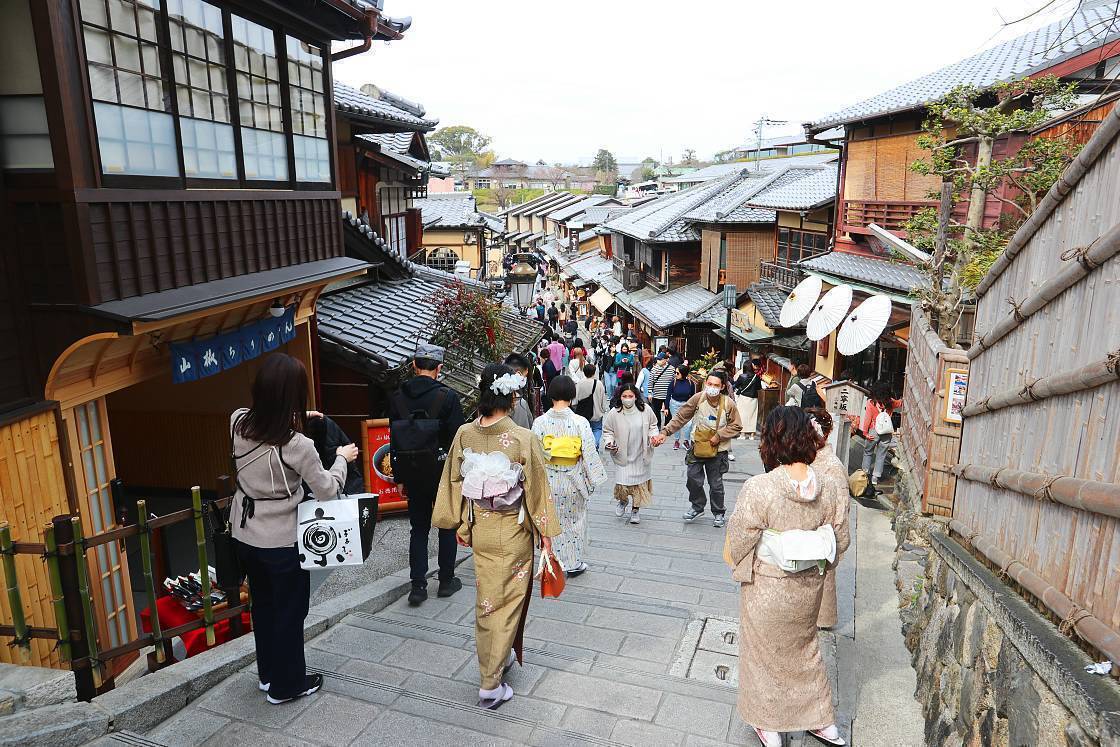
As a special treat, I made a stop at Kasagiya - a wonderfully atmospheric little teahouse tucked away beside the stone steps at the upper end of the street. Taking a seat at one of the little tables, I ordered a bowl of light matcha with a serving of ohagi - a sweet made from sticky steamed rice coated with sweet bean paste.
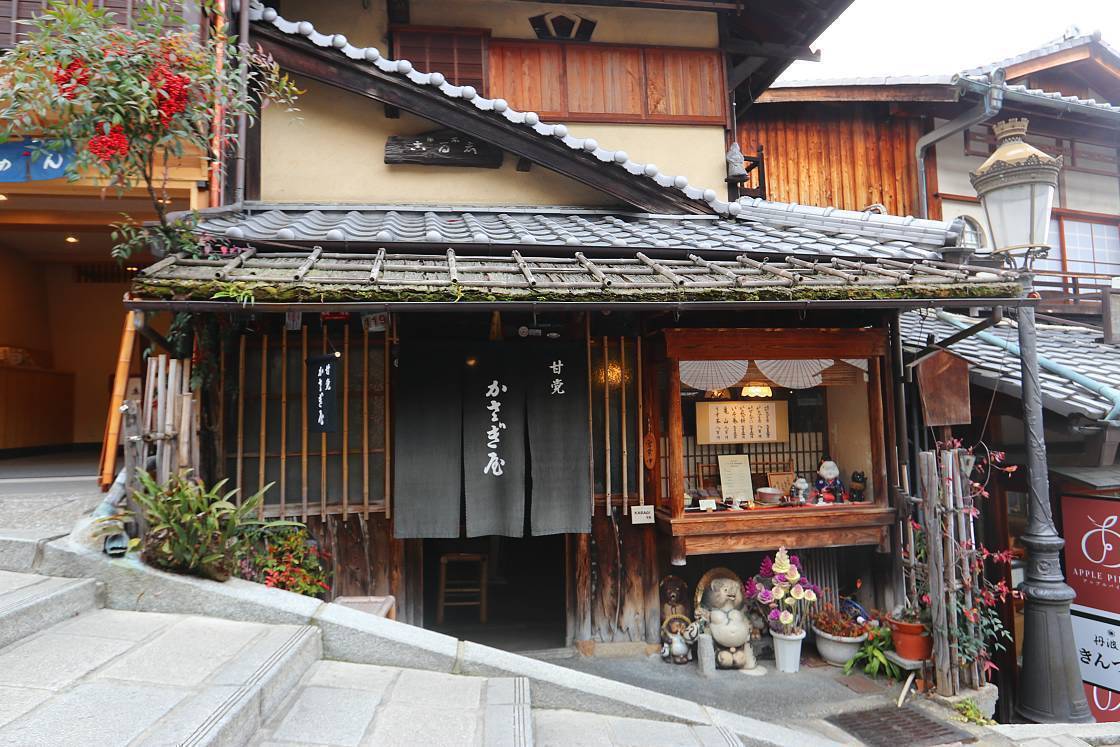
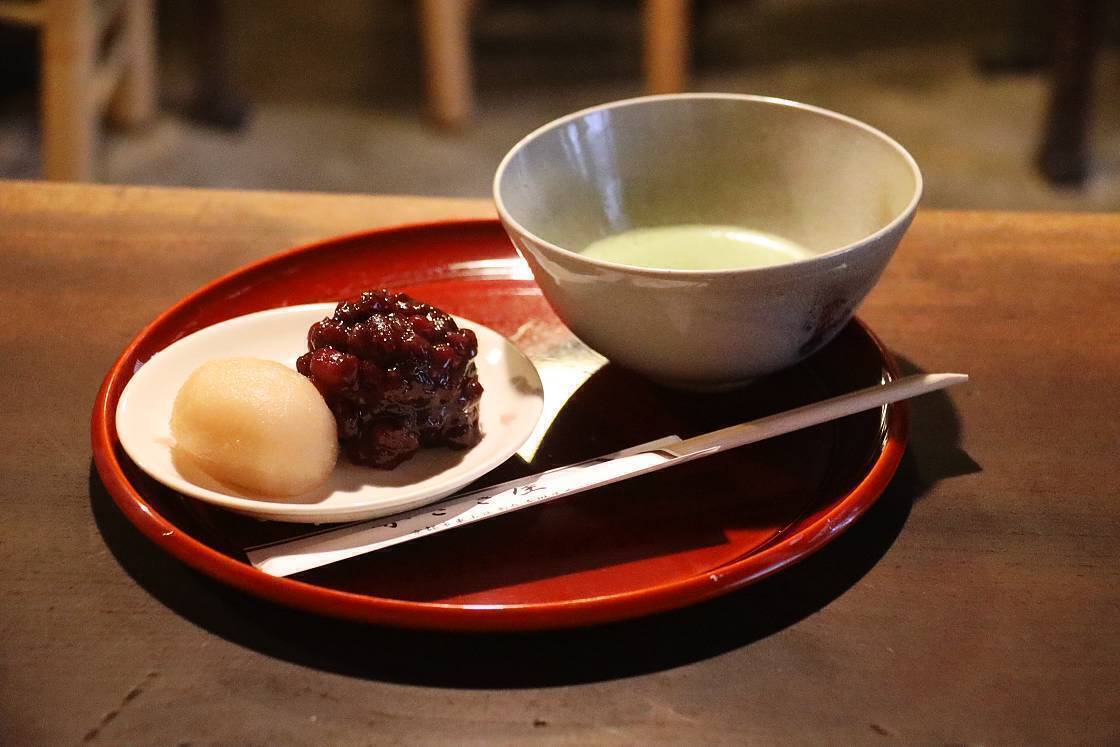

Feeling refreshed, it was time for the last stop of my Kyoto day trip, and a short stroll along Shirakawa-dori, often described by locals as Kyoto's most beautiful street. Named after the quietly babbling river it runs alongside, the area boasts more of the same beautifully preserved wooden buildings but ups the ante with a mix of willow and cherry blossom trees, while herons can sometimes be spotted keeping watch over the flowing water.
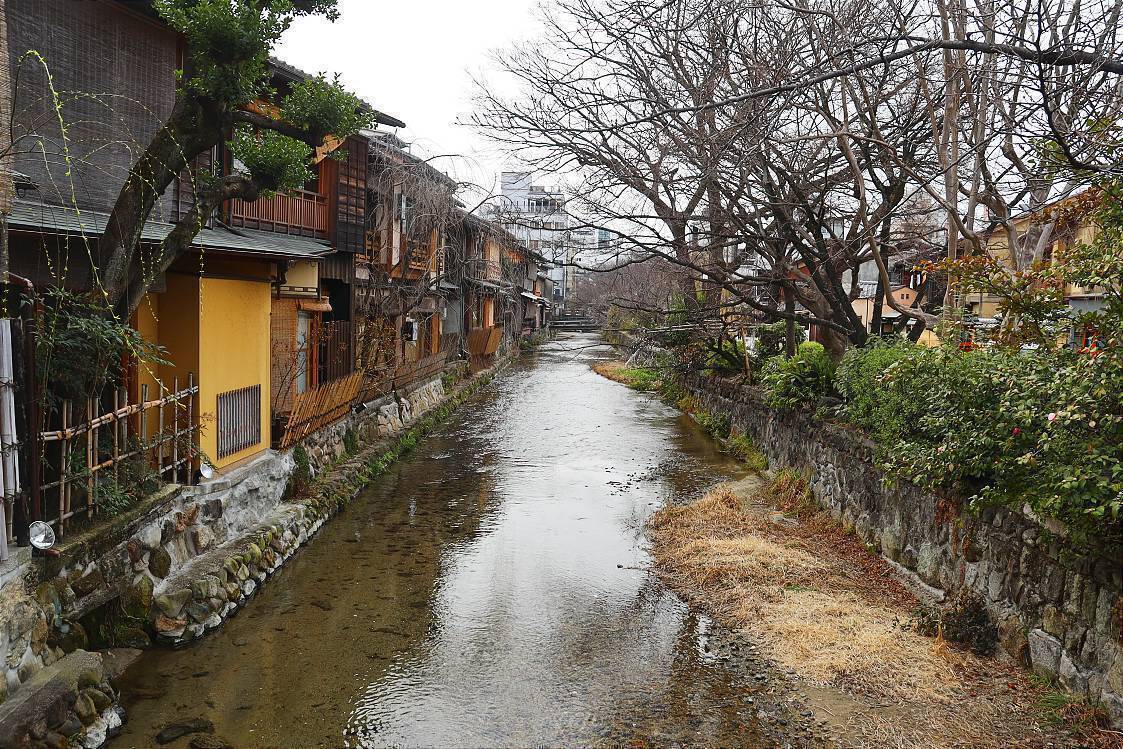
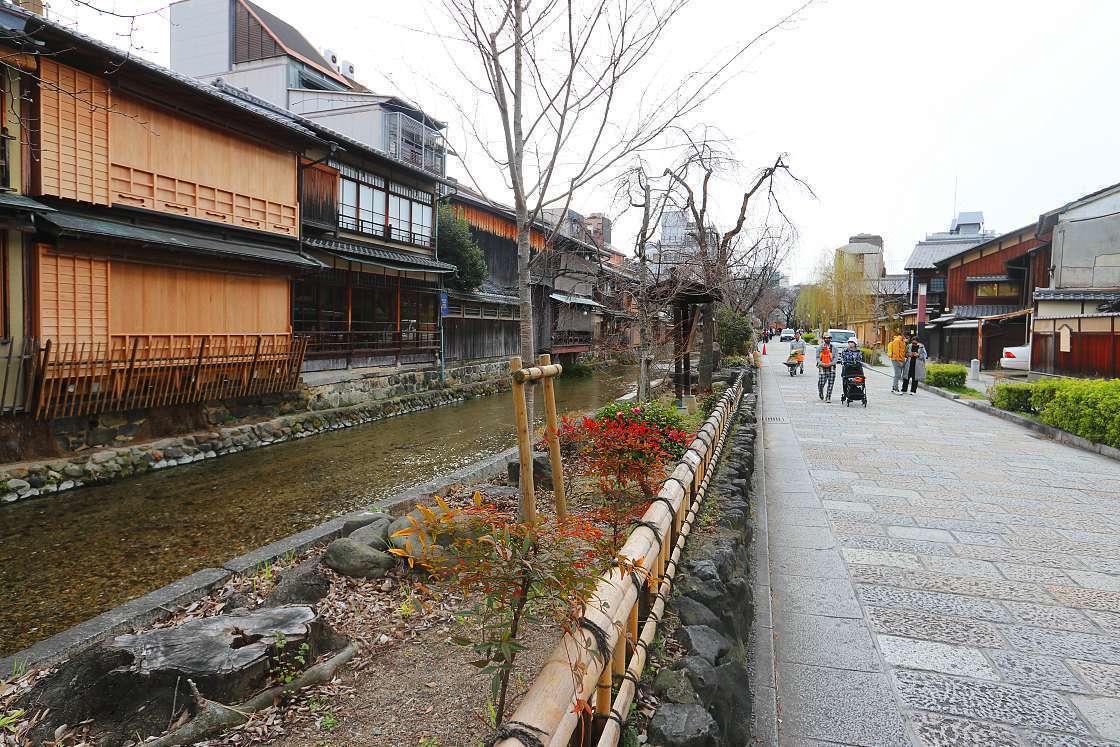
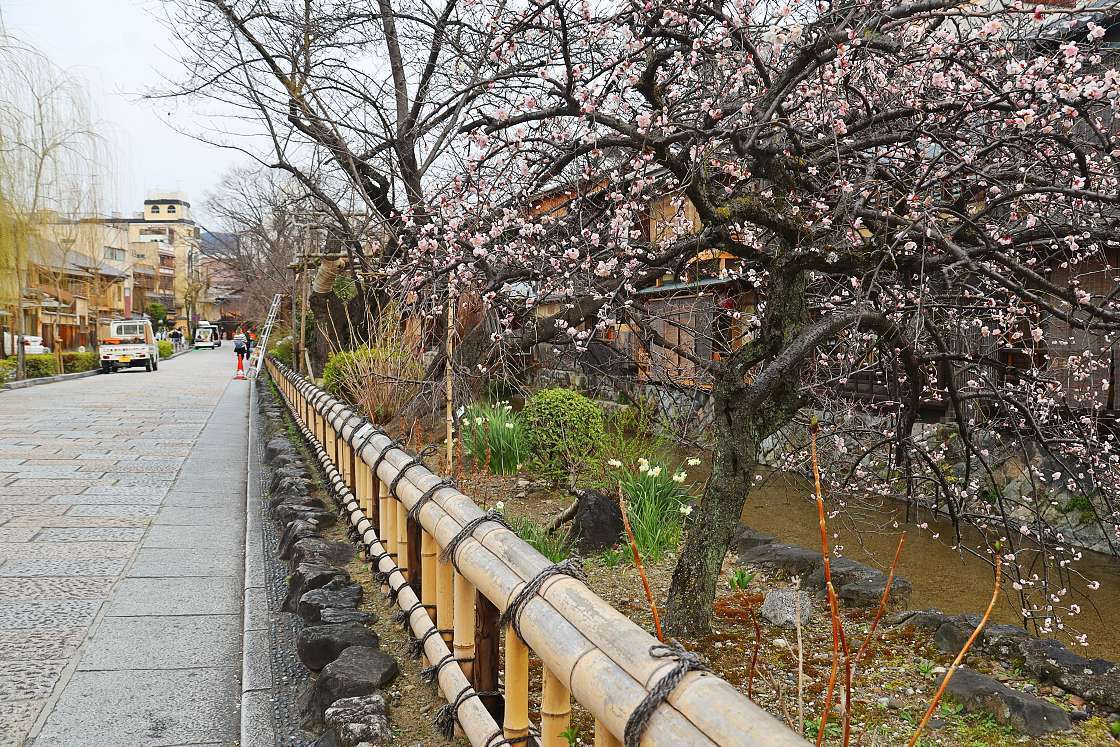
Day trip to Kobe
My first destination on the second day was Mount Rokko - a name that refers not to a single peak but an entire mountain range, forming a spectacular natural backdrop to the coastal city of Kobe. Reaching 931 meters above sea level at its highest point, the range is especially well known for its sweeping views of the city and the ocean beyond.
Hopping onto a local train on the Hankyu Kobe Line, I took a 35-minute ride to Rokko Station, then a local bus for the short journey to the Rokko Lower Cable Station - a faithful reconstruction of the original structure that first opened in 1932. The ropeway's current third-generation carriages have preserved a stately appearance - with two nostalgic color schemes and natural wooden fittings.
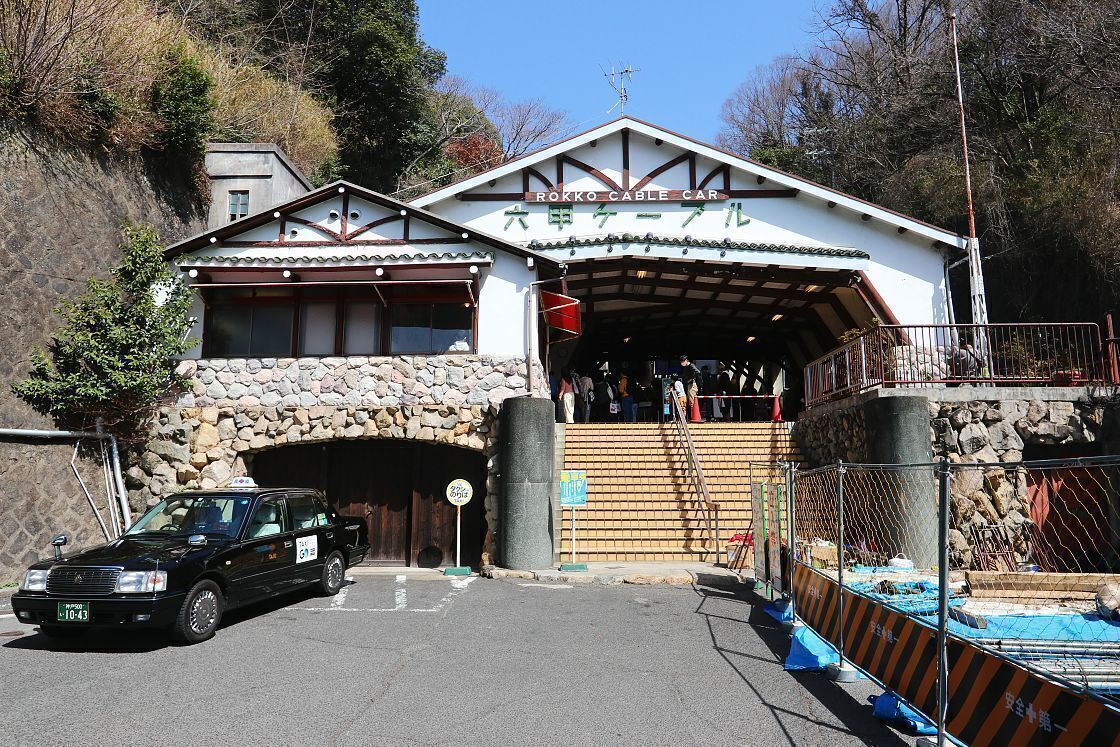
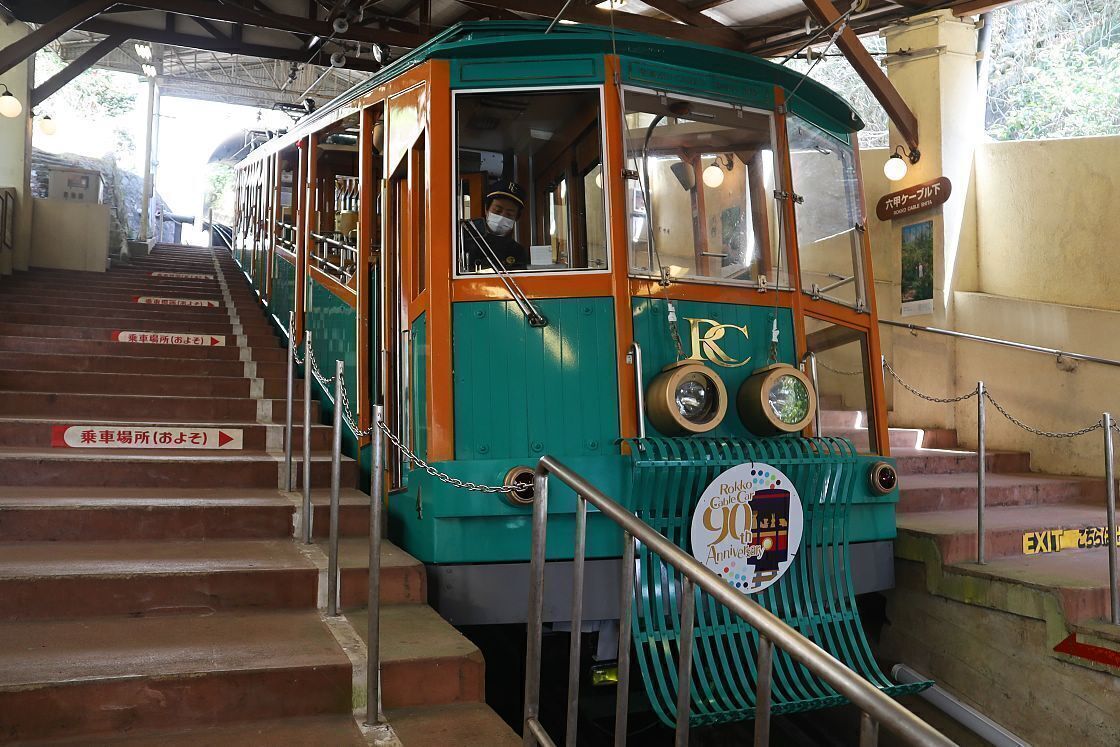
It takes a leisurely ten minutes to reach Rokko Sanjo Station at the summit, and while the surrounding undergrowth blocks out some of the view, passengers can enjoy pleasant forest surroundings through large windows and a glass roof on the lower section of the car.
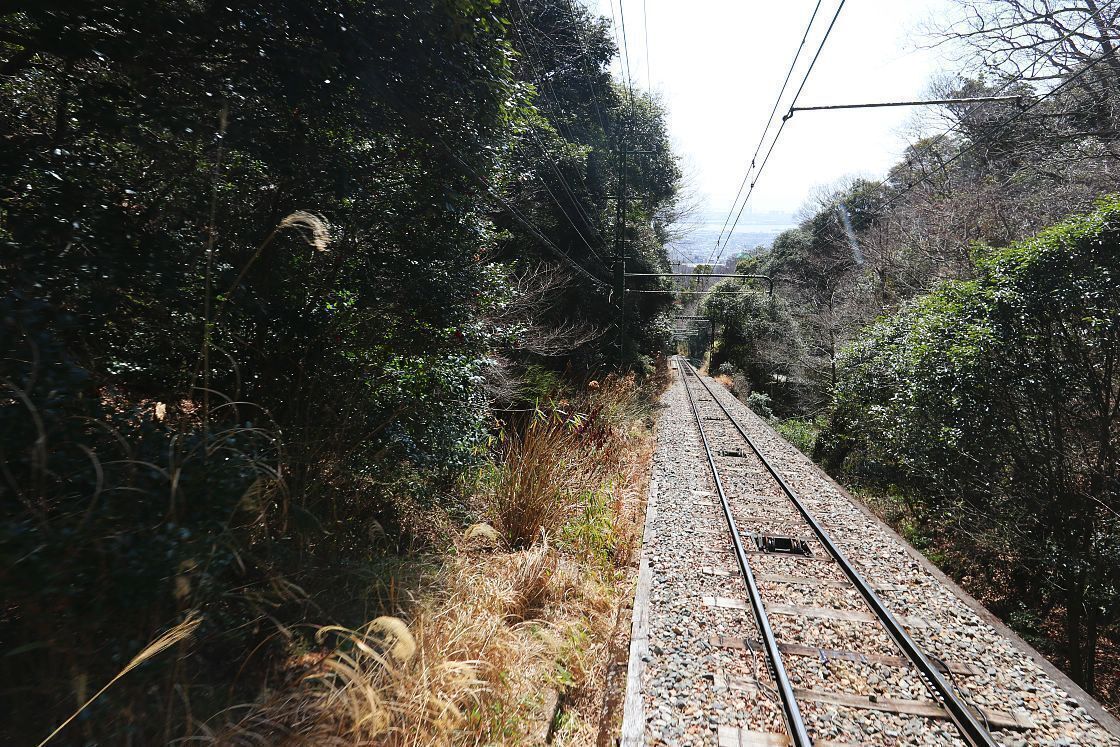
The mountaintop area boasts a number of attractions, any of which can be easily reached by buses stopping just a few steps from entrance to Rokko Sanjo Station. With a few minutes to spare, I took a pause to enjoy the incredible view from the nearby Tenrandai (heaven viewing platform), an observation deck named in honor of a visit by Emperor Showa back in 1981.
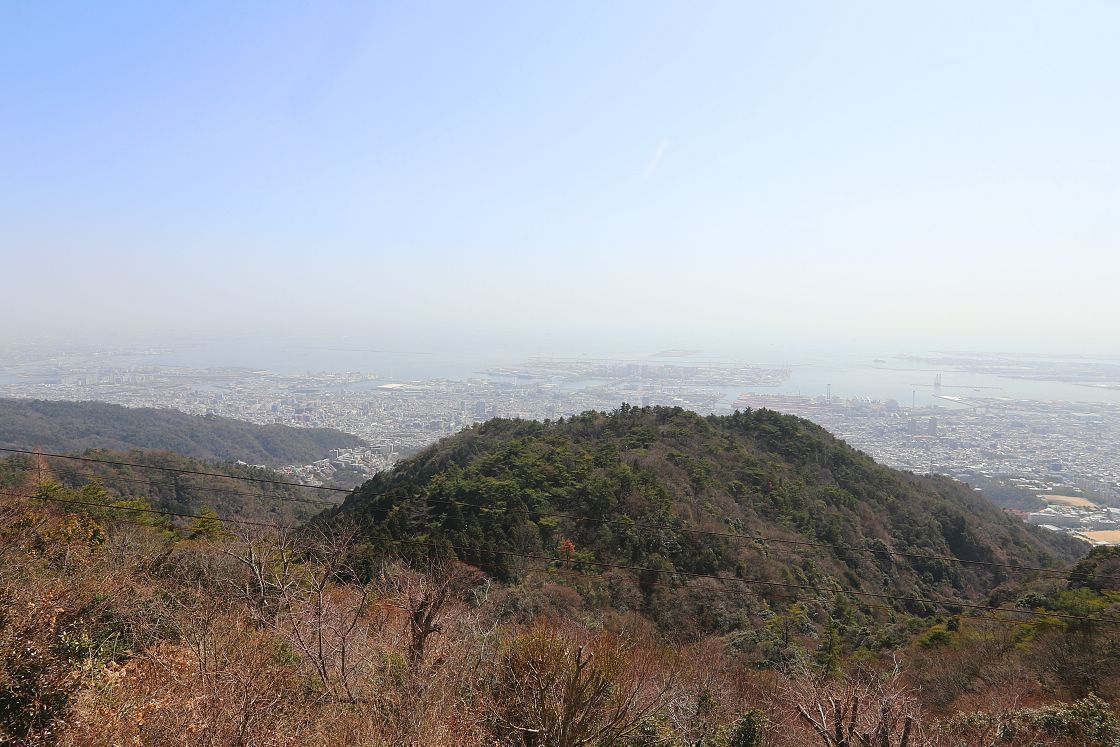
Boarding a bus, I took a pleasant ten-minute ride to Rokko Garden Terrace - an attractive development with the feel of a European town, featuring several small shops and restaurants arranged around a stone-paved observatory.
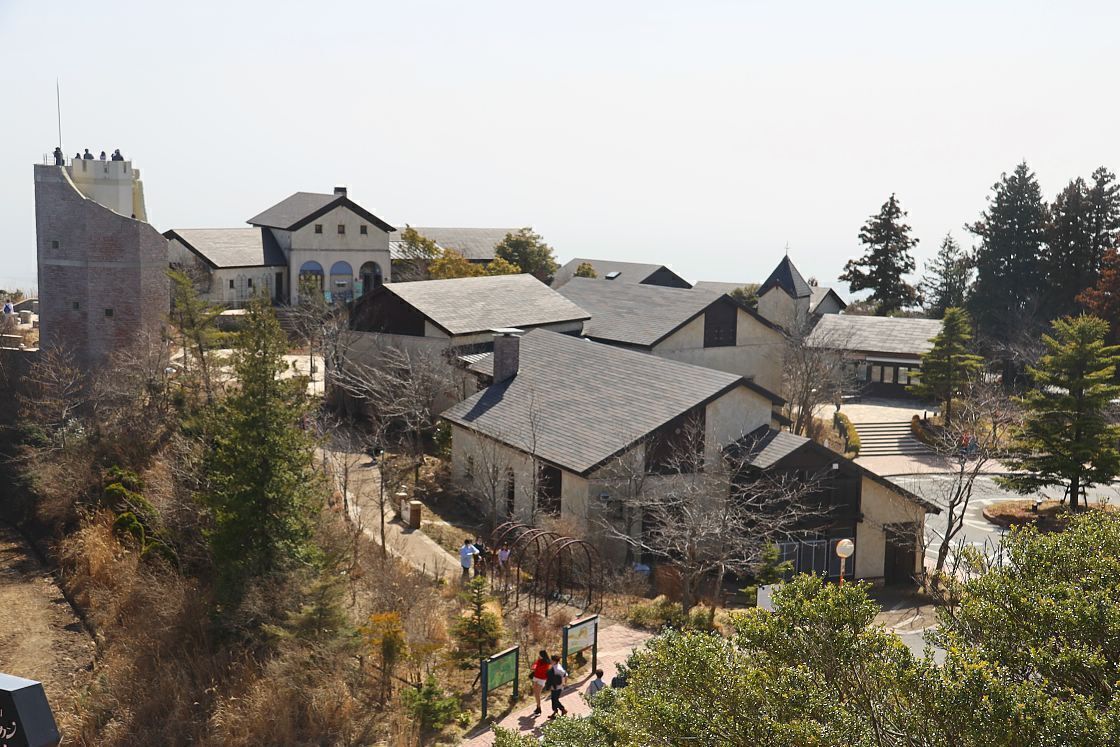
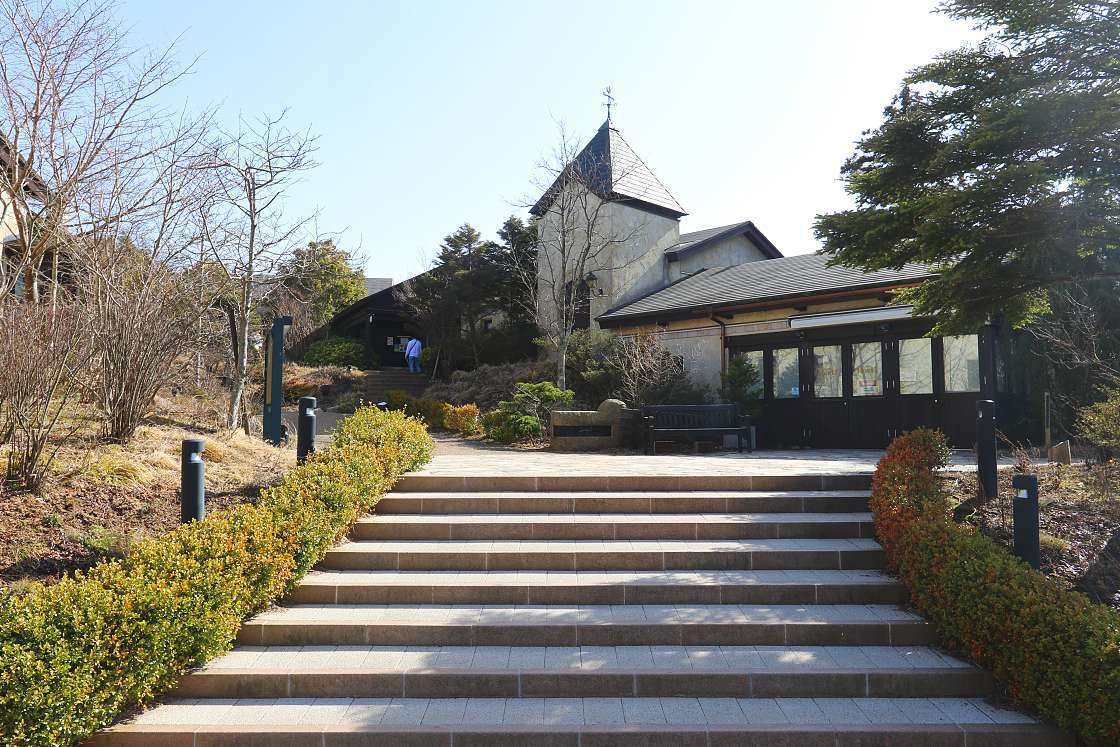
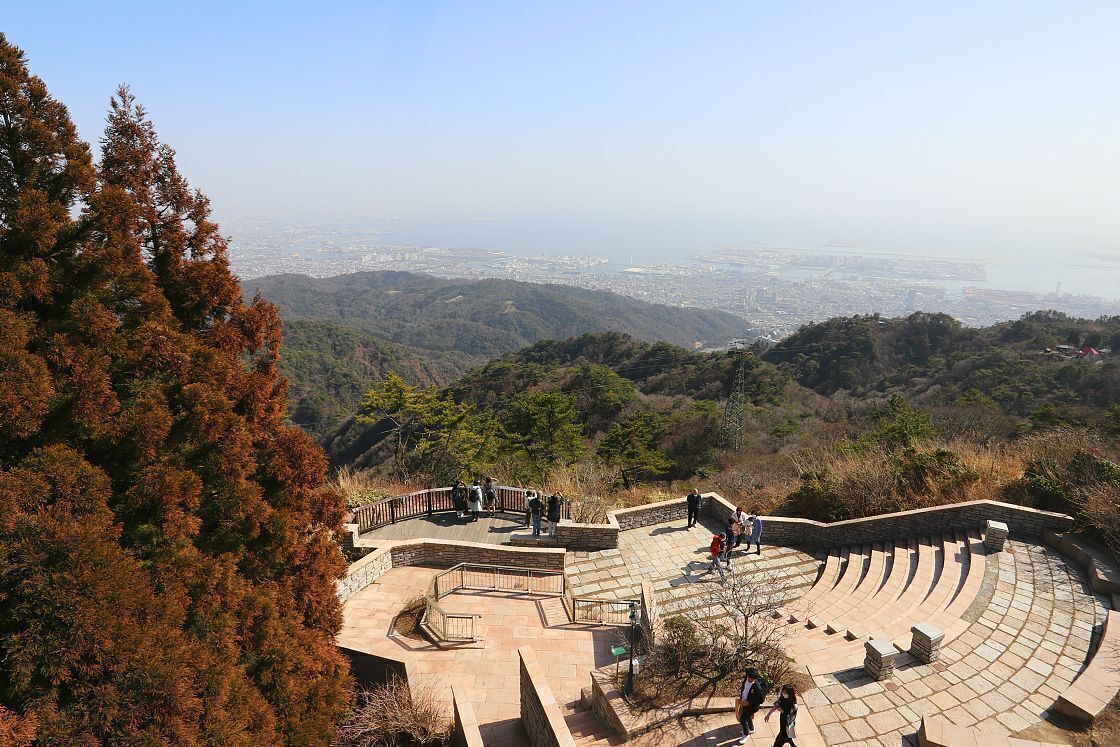
Set slightly apart from the terrace is an eye-catching structure known as the Rokko-Shidare Observatory. Designed by the renowned architect Sambuichi Hiroshi, the observatory takes the form of a mesh dome around an interior space reminiscent of a tree trunk, accessible via a slope to either side.
From August 26th through to November 23rd, the summit area will see the return of the Rokko Meets Art Walk - an annual festival in which a fascinating series of art installations will appear in Rokko's outdoor spaces and various tourist attractions. In previous years, the works on display have ranged from large scale sculptures to light up events and even interactive VR installations, so visitors a little later in the year can expect an exciting new dimension to sightseeing on the mountain.
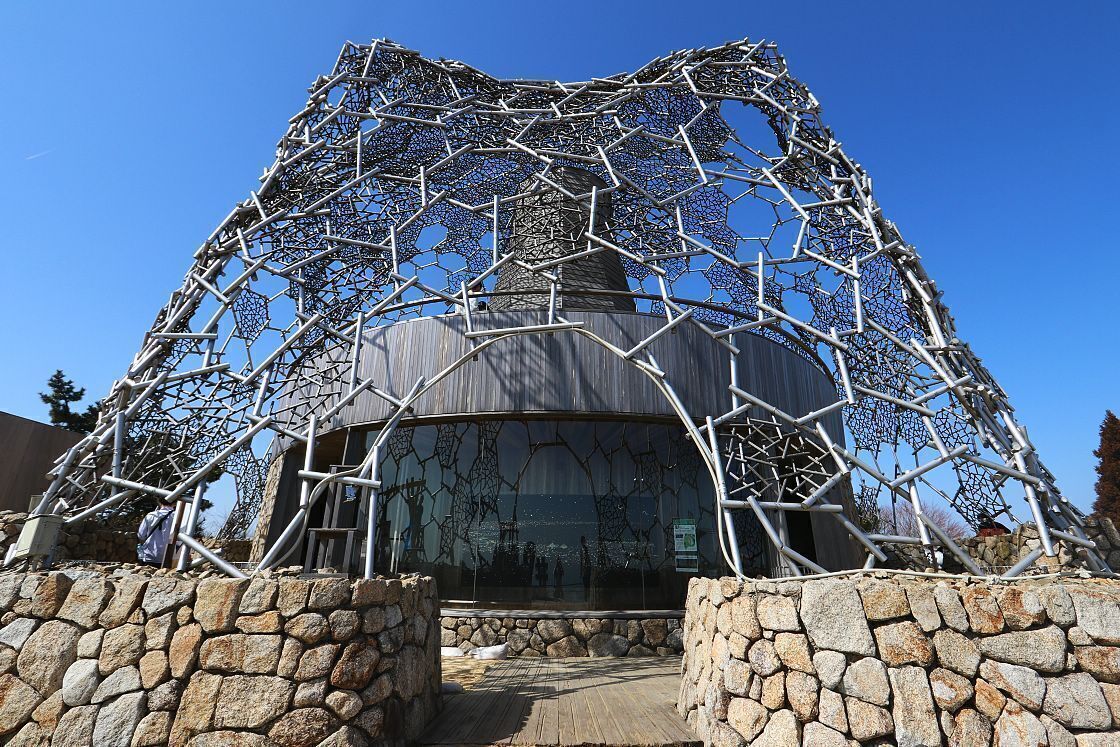
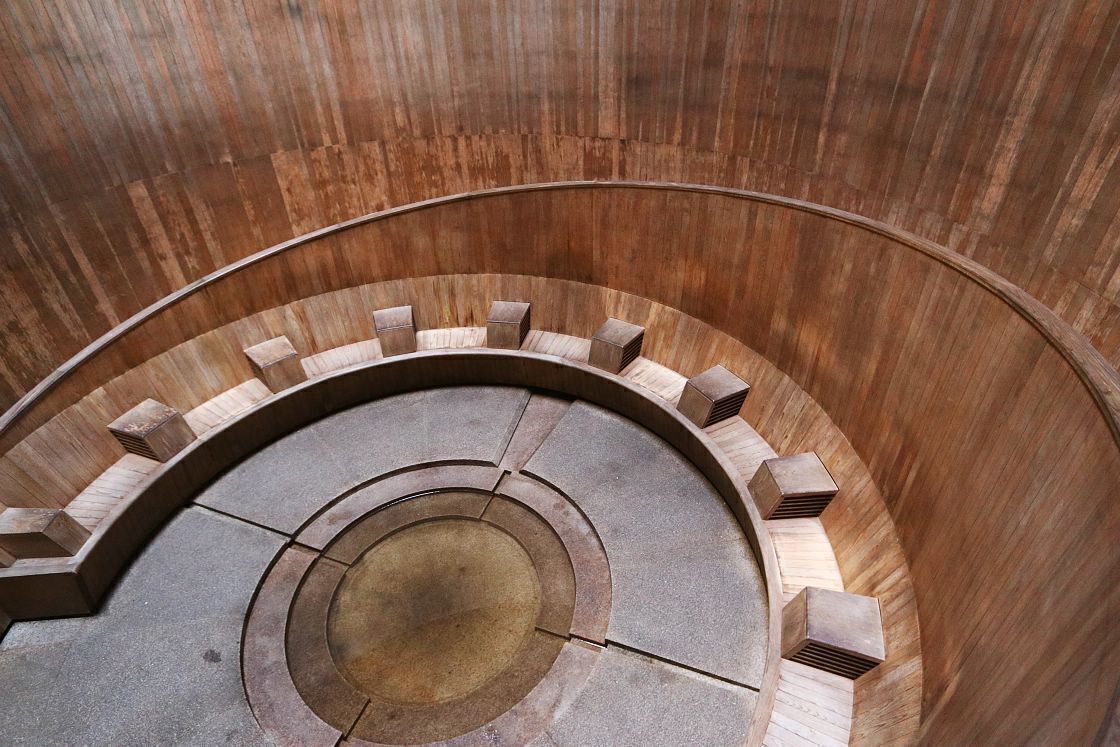
Setting off from Rokko Garden Terrace, I took a 15 minute stroll along winding, tree-lined roads to the Rokko Alpine Botanical Garden. First opened in 1933, the garden sits at an altitude of 865 meters, allowing visitors to enjoy up to 1,500 species of predominantly alpine and cold-weather plants in conditions approaching their natural environment.
Despite a few weeks of warm and sunny weather, the garden still had some way to go before it reached its best, with just a handful of flowers to be seen. Still, it was fun to explore the 50,000 square meters or so of beautifully landscaped garden, and I could easily imagine the spectacular sights awaiting visitors in the weeks to come.

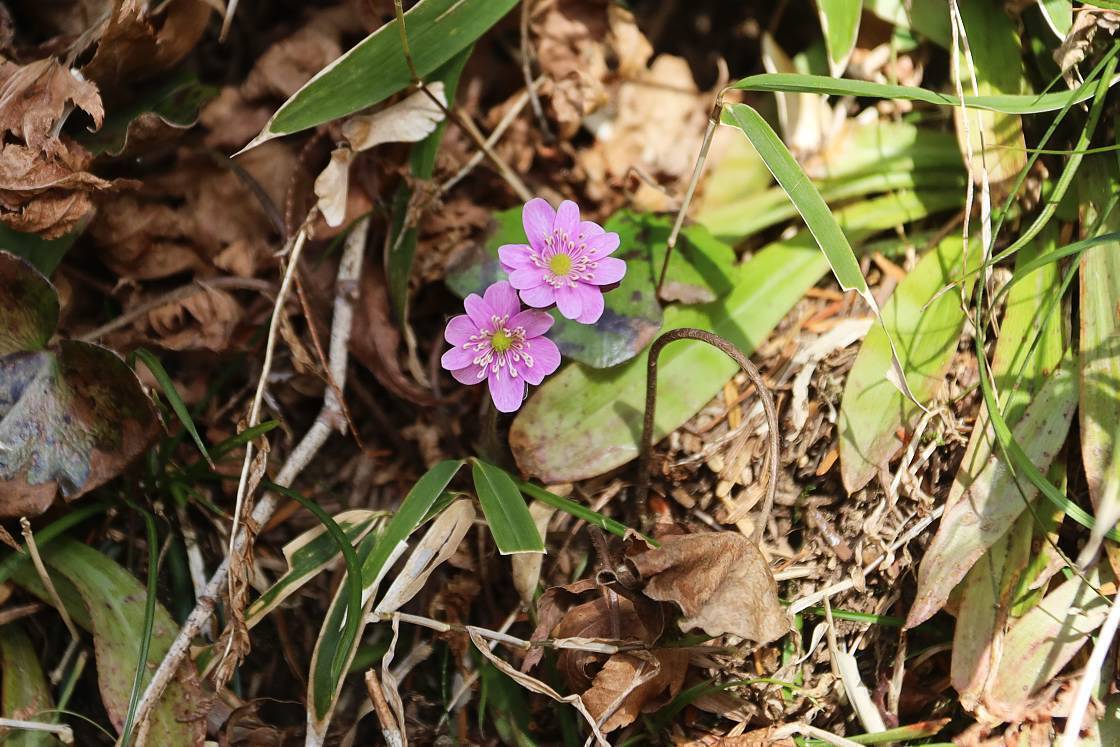
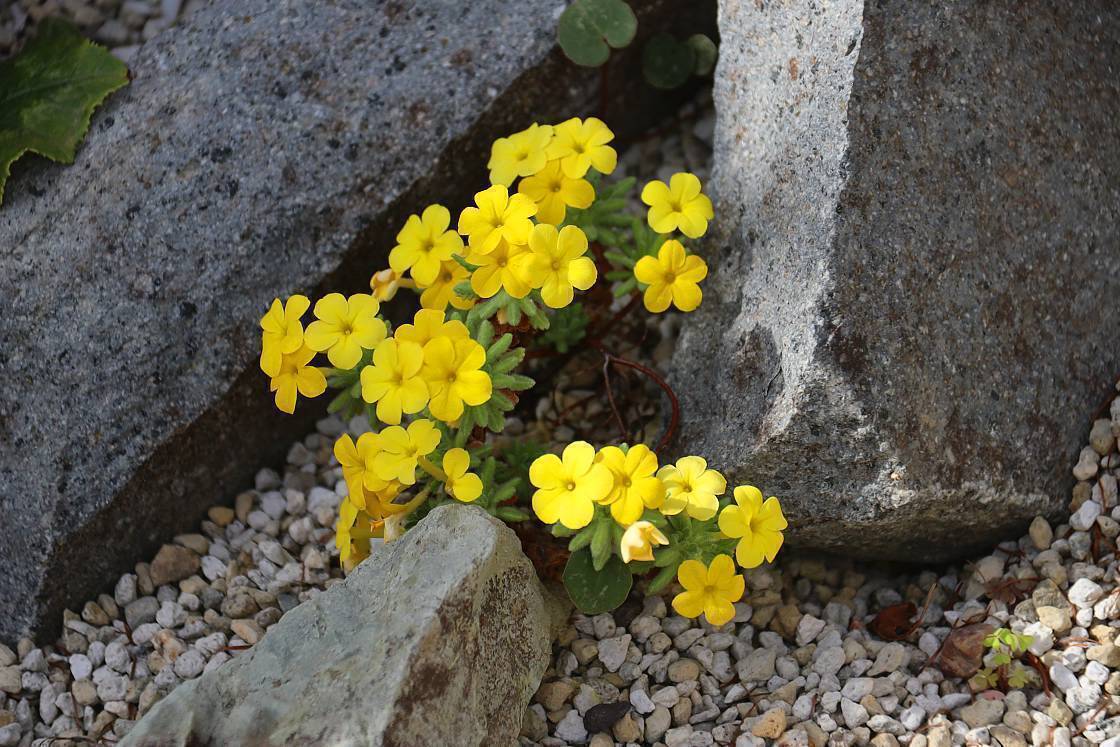
After checking out the garden, it was time to begin making my way to the second destination of the day, so I hopped onto another bus from just outside the nearby Rokko Morinone Museum for the short ride back to Rokko Sanjo Station. Retracing my steps to Rokko Station, I followed the Hankyu Railway tracks southwest as far as the Toga River. From here, it was a gentle 20-minute stroll along a paved riverside path to Kobe's Nada District - known for centuries as Japan's top sake producing region.
The secret to Nada's success lies in the unique mineral composition of water produced in abundance by nearby Mount Rokko, known in the sake industry as miyamizu. While rich in potassium, magnesium and phosphoric acid - all vital to the brewing process - the water is also especially low in iron, known for its negative influence on flavor and even coloration.
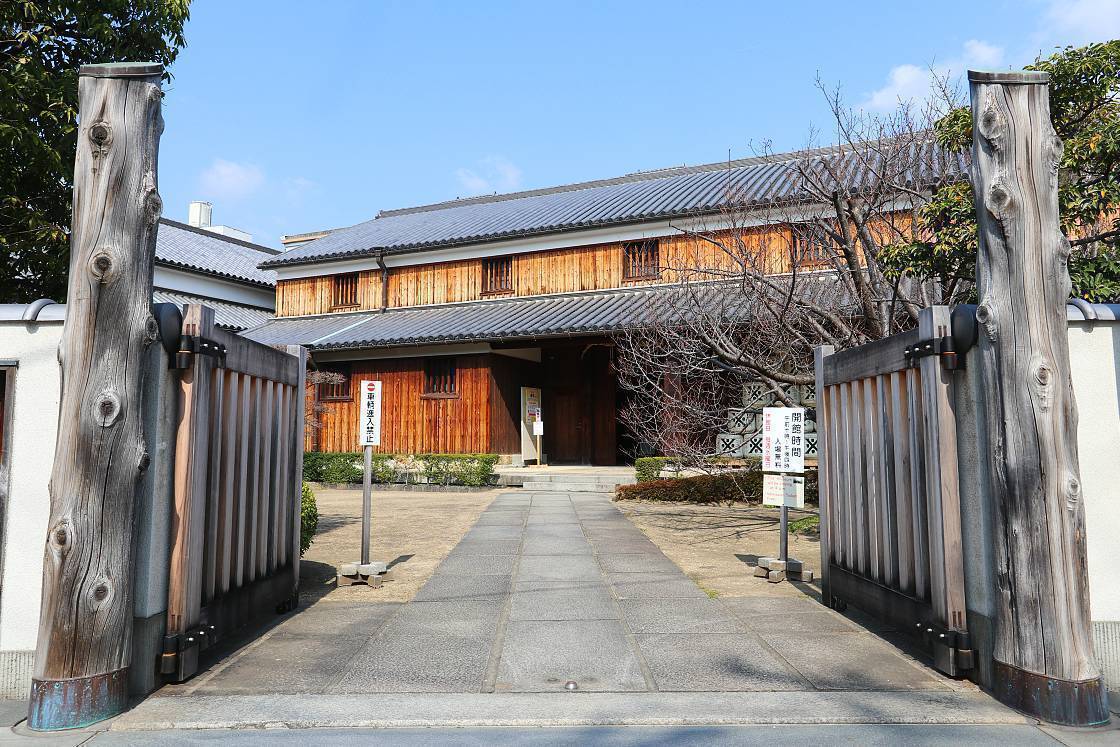

Today, several of the major brewing companies based in the area have preserved their historic buildings in the form of free-to-enter museums - perfect for a few hours of relaxed sightseeing.
After stopping to check out a few of these, I rounded off my time in Kobe with a guided tour of the prestigious Shushinkan Sake Brewery, home to the internationally renowned Fukuju brand.
